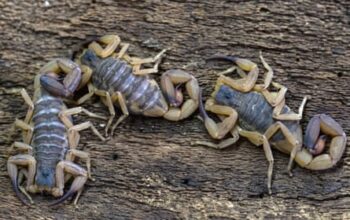
Researchers have discovered that two small, oval fossils previously believed to be prehistoric plants are in fact the preserved remains of baby marine turtles.
During the mid-20th century, Padre Gustavo Huerta, a priest with a passion for fossilized plants, uncovered fossils in Colombia that are estimated to be between 132 and 113 million years old.
In the beginning, it was believed that the fossils belonged to a type of sphenophyllum, a plant that is no longer in existence and is related to present-day “horsetails.” The leaves were thought to be divided into wedge shapes with veins branching out from their bases. However, specialists have since realized that this was an error.
“While examining the fossils again, our goal was to locate leaf veins. However, we came across a fragile layer of porous bone tissue, causing us to dismiss the idea that these fossils belonged to plants,” stated Prof Edwin Cadena, a collaborator of the research from Universidad del Rosario in Bogotá.
“Instead, we started to compare them to fossils of vertebrates, which immediately evoked images of newly hatched turtles in our minds.”
In the journal Palaeontologia Electronica, the researchers detail their examination of the fossils in relation to living marine turtles and fossils of a different type of sphenophyllum.
The team has announced that the oval fossils, measuring 5cm and 6cm, are actually the carapaces or hard shells of marine turtles. Previously believed to be leaf veins, the patterns on the shells are now recognized as bone growth. The fossils also show evidence of neurals and costals, as well as serrated joints between them.
The scientists suggest that the turtles were likely younger than one year and potentially belonged to the Desmatochelys padillai species. These turtles were a type of protostegid, a group of ancient sea turtles that included some of the largest known to exist.
Nonetheless, as a tribute to the initial mistaken identity, the group has dubbed them “Turtwig”, in reference to a hybrid Pokémon creature with both turtle and plant characteristics.
According to Dr. Nick Fraser, a vertebrate paleontology expert at National Museums Scotland, who was not part of the research team, the revised interpretation is more logical. This is because sphenophyllum was present during the Paleozoic era, while the fossil deposits date back to the later Mesozoic era. This discrepancy, as described by Cadena, is similar to mistakenly claiming that dinosaurs and mammoths coexisted.
Fraser commented: “The revised interpretation holds significant significance and accurately depicts the hatchling turtles’ identity. It is uncommon to find early stage turtles in the fossil record, so further examination, such as CT analysis, could provide valuable insight into identifying the species.”
According to Professor Andy Gale from the University of Portsmouth, the specimens are definitely hatchling turtles and not plants. He also noted that it is not uncommon to misidentify something when you have a preconceived idea of what you are looking for.
Source: theguardian.com


